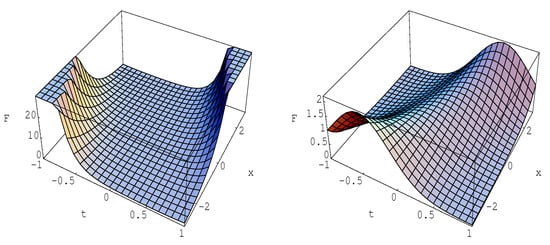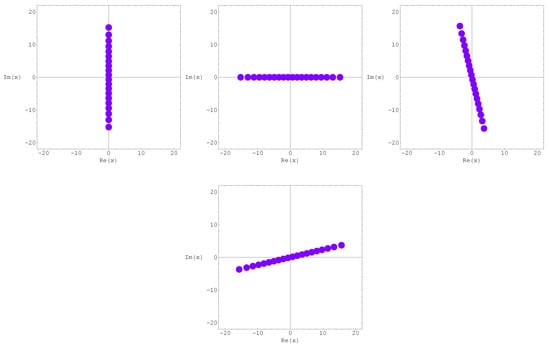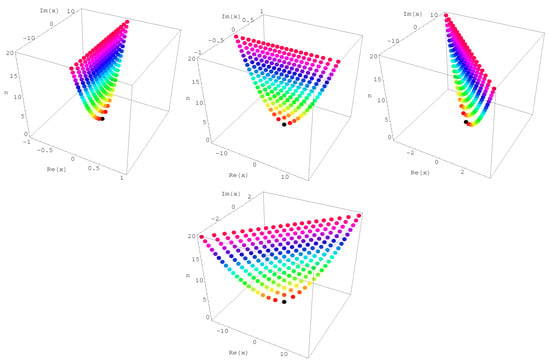Abstract
In this paper, we study differential equations arising from the generating functions of Hermit Kamp de Friet polynomials. Use this differential equation to give explicit identities for Hermite Kamp de Friet polynomials. Finally, use the computer to view the location of the zeros of Hermite Kamp de Friet polynomials.
Keywords:
differential equations, heat equation; Hermite Kampé de Fériet polynomials; Hermite polynomials; generating functions 2000 Mathematics Subject Classification:
05A19; 11B83; 34A30; 65L99
1. Introduction
Numerous studies have been conducted on Bernoulli polynomials, Euler polynomials, tangent polynomials, Hermite polynomials and Laguerre polynomials (see [1,2,3,4,5,6,7,8,9,10,11,12,13]). The special polynomials of the two variables provided a new way to analyze solutions of various kinds of partial differential equations that are often encountered in physical problems. Most of the special function of mathematical physics and their generalization have been proposed as physical problems. For example, we recall that the two variables Hermite Kamp de Friet polynomials defined by the generating function (see [2])
are the solution of heat equation
We note that where are the classical Hermite polynomials (see [1]). The differential equation and relation are given by
respectively.
By (1) and Cauchy product, we get
By comparing the coefficients on both sides of (2), we have the following theorem:
Theorem 1.
For any positive integer n, we have
The following elementary properties of the two variables Hermite Kamp de Friet polynomials are readily derived from (1).
Theorem 2.
For any positive integer n, we have
Recently, many mathematicians have studied differential equations that occur in the generating functions of special polynomials (see [8,9,14,15,16]). The paper is organized as follows. We derive the differential equations generated from the generating function of Hermite Kamp de Friet polynomials:
By obtaining the coefficients of this differential equation, we obtain explicit identities for the Hermite Kamp de Friet polynomials in Section 2. In Section 3, we investigate the zeros of the Hermite Kamp de Friet polynomials using numerical methods. Finally, we observe the scattering phenomenon of the zeros of Hermite Kamp de Friet polynomials.
2. Differential Equations Associated with Hermite Kamp de Friet Polynomials
In order to obtain explicit identities for special polynomials, differential equations arising from the generating functions of special polynomials are studied by many authors (see [8,9,14,15,16]). In this section, we introduce differential equations arising from the generating functions of Hermite Kamp de Friet polynomials and use these differential equations to obtain the explicit identities for the Hermite Kamp de Friet polynomials.
Let
Then, by (3), we have
and
If we continue this process, we can guess as follows:
Differentiating (4) with respect to t, we have
Now, replacing N by in (4), we find
Comparing the coefficients on both sides of (5) and (6), we obtain
and
In addition, by (4), we have
which gives
It is not difficult to show that
Thus, by (11), we also find
From (7), we note that
and
For in (8), we have
Continuing this process, we can deduce that, for
Note that here the matrix is given by
Therefore, we obtain the following theorem.
Theorem 3.
Forthe differential equation
has a solution
where
Making N-times derivative for (3) with respect to t, we have
By Cauchy product and multiplying the exponential series in both sides of (18), we get
For non-negative integer m, assume that are four sequences given by
If we have the following inverse relation:
By (20) and the Leibniz rule, we have
Hence, by (19) and (21), and comparing the coefficients of gives the following theorem.
Theorem 4.
Let be nonnegative integers. Then,
If we take in (22), then we have the following:
Corollary 1.
For we have
For the differential equation
has a solution
Here is a plot of the surface for this solution.

Figure 1.
The surface for the solution .
3. Zeros of the Hermite Kamp de Friet Polynomials
By using software programs, many mathematicians can explore concepts more easily than in the past. These experiments allow mathematicians to quickly create and visualize new ideas, review properties of figures, create many problems, and find and guess patterns. This numerical survey is particularly interesting because it helps many mathematicians understand basic concepts and solve problems. In this section, we examine the distribution and pattern of zeros of Hermite Kamp de Friet polynomials according to the change of degree n. Based on these results, we present a problem that needs to be approached theoretically.
By using a computer, the Hermite Kamp de Friet polynomials can be determined explicitly. First, a few examples of them are as follows:
Using a computer, we investigate the distribution of zeros of the Hermite Kamp de Friet polynomials .
Plots the zeros of the polynomial for and are as follows (Figure 1). In Figure 2 (top-left), we choose and . In Figure 2 (top-right), we choose and . In Figure 2 (bottom-left), we choose and . In Figure 2 (bottom-right), we choose and .

Figure 2.
Zeros of .
Stacks of zeros of the Hermite Kamp de Friet polynomials for from a 3D structure are presented (Figure 3). In Figure 3 (top-left), we choose . In Figure 3 (top-right), we choose . In Figure 3 (bottom-left), we choose . In Figure 3 (bottom-right), we choose . Our numerical results for approximate solutions of real zeros of the Hermite Kamp de Friet polynomials are displayed (Table 1,Table 2,Table 3).

Figure 3.
Stacks of zeros of .

Table 1.
Numbers of real and complex zeros of .

Table 2.
Numbers of real and complex zeros of .

Table 3.
Approximate solutions of .
The plot of real zeros of the Hermite Kamp de Friet polynomials for structure are presented (Figure 4). It is expected that , has reflection symmetry analytic complex functions (see Figure 2 and Figure 3). We also expect that , has reflection symmetry analytic complex functions (see Figure 2, Figure 3 and Figure 4). We observe a remarkable regular structure of the complex roots of the Hermite Kamp de Friet polynomials for . We also hope to verify a remarkable regular structure of the complex roots of the Hermite Kamp de Friet polynomials for (Table 1). Next, we calculated an approximate solution that satisfies . The results are shown in Table 3.

Figure 4.
Real zeros of .
4. Conclusions and Future Developments
This study obtained the explicit identities for Hermite Kamp de Friet polynomials . The location and symmetry of the roots of the Hermite Kamp de Friet polynomials were investigated. We examined the symmetry of the zeros of the Hermite Kamp de Friet polynomials for various variables x and y, but, unfortunately, we could not find a regular pattern. However, the following special cases showed regularity. Through numerical experiments, we will make the following series of conjectures.
If , we can see that has reflection symmetry. Therefore, the following conjecture is possible.
Conjecture 1.
Prove or disprove thatandhasreflection symmetry analytic complex functions. Furthermore,hasreflection symmetry for.
As a result of investigating more n variables, it is still unknown whether the conjecture is true or false for all variables n (see Figure 1).
Conjecture 2.
Prove or disprove that has n distinct solutions.
Let’s use the following notations. denotes the number of real zeros of lying on the real plane and denotes the number of complex zeros of . Since n is the degree of the polynomial , we have (see Table 1 and Table 2).
Conjecture 3.
Prove or disprove that
Funding
This work was supported by the National Research Foundation of Korea (NRF) grant funded by the Korea government (MEST) (No. 2017R1A2B4006092).
Acknowledgments
The authors would like to thank the referees for their valuable comments, which improved the original manuscript in its present form.
Conflicts of Interest
The authors declare no conflict of interest.
References
- Andrews, L.C. Special Functions for Engineers and Mathematicians; Macmillan. Co.: New York, NY, USA, 1985. [Google Scholar]
- Appell, P.; de Fériet, J.K. Fonctions Hypergéométriques et Hypersphériques: Polynomes d Hermite; Gauthier-Villars: Paris, France, 1926. [Google Scholar]
- Erdelyi, A.; Magnus, W.; Oberhettinger, F.; Tricomi, F.G. Higher Transcendental Functions; Krieger: New York, NY, USA, 1981; Volume 3. [Google Scholar]
- Gala, S.; Ragusa, M.A.; Sawano, Y.; Tanaka, H. Uniqueness criterion of weak solutions for the dissipative quasi-geostrophic equations in Orlicz-Morrey spaces. Appl. Anal. 2014, 93, 356–368. [Google Scholar] [CrossRef]
- Guariglia, E. On Dieudonns boundedness theorem. J. Math. Anal. Appl. 1990, 145, 447–454. [Google Scholar] [CrossRef]
- Kang, J.Y.; Lee, H.Y.; Jung, N.S. Some relations of the twisted q-Genocchi numbers and polynomials with weight α and weak Weight β. Abstr. Appl. Anal. 2012, 2012, 860921. [Google Scholar] [CrossRef]
- Kim, M.S.; Hu, S. On p-adic Hurwitz-type Euler Zeta functions. J. Number Theory 2012, 132, 2977–3015. [Google Scholar] [CrossRef]
- Kim, T.; Kim, D.S.; Kwon, H.I.; Ryoo, C.S. Differential equations associated with Mahler and Sheffer-Mahler polynomials. To appear in Nonlinear Functional Analysis and Application.
- Kim, T.; Kim, D.S. Identities involving degenerate Euler numbers and polynomials arising from non-linear differential equations. J. Nonlinear Sci. Appl. 2016, 9, 2086–2098. [Google Scholar] [CrossRef]
- Ozden, H.; Simsek, Y. A new extension of q-Euler numbers and polynomials related to their interpolation functions. Appl. Math. Lett. 2008, 21, 934–938. [Google Scholar] [CrossRef]
- Robert, A.M. A Course in p-adic Analysis. In Graduate Text in Mathematics; Springer: Berlin/Heidelberg, Germany, 2000; Volume 198. [Google Scholar]
- Roman, S. The Umbral Calculus, Pure and Applied Mathematics; Academic, Press Inc.: New York, NY, USA; Harcourt Brace Jovanovich Publishes: San Diego, CA, USA, 1984; Volume 111. [Google Scholar]
- Simsek, Y. Complete Sum of Products of (h,q)-Extension of Euler Polynomials and Numbers. J. Differ. Equ. Appl. 2010, 16, 1331–1348. [Google Scholar] [CrossRef]
- Ryoo, C.S. Differential equations associated with generalized Bell polynomials and their zeros. Open Math. 2016, 14, 807–815. [Google Scholar] [CrossRef]
- Ryoo, C.S. Differential equations associated with the generalized Euler polynomials of the second kind. J. Comput. Appl. Math. 2018, 24, 711–716. [Google Scholar]
- Ryoo, C.S.; Agarwal, R.P.; Kang, J.Y. Differential equations associated with Bell-Carlitz polynomials and their zeros. Neural Parallel Sci. Comput. 2016, 24, 453–462. [Google Scholar]
© 2018 by the author. Licensee MDPI, Basel, Switzerland. This article is an open access article distributed under the terms and conditions of the Creative Commons Attribution (CC BY) license (http://creativecommons.org/licenses/by/4.0/).